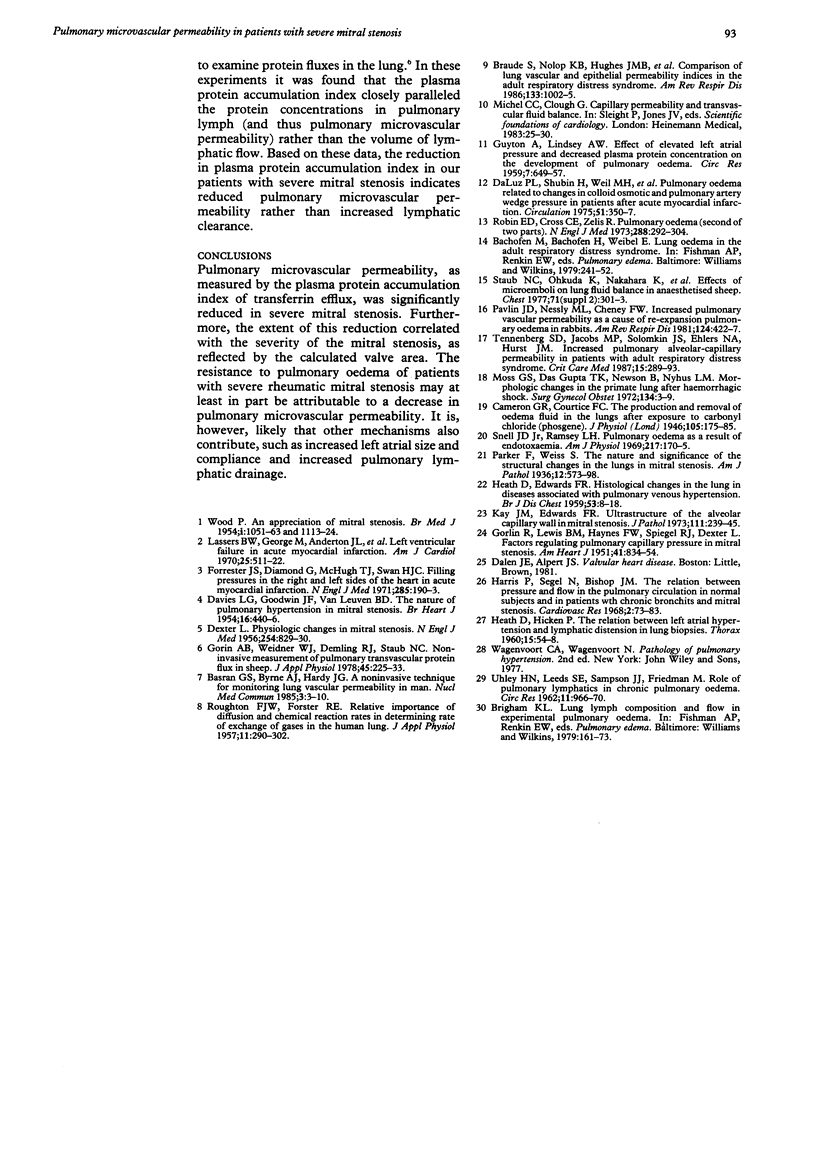Abstract
Patients with rheumatic mitral stenosis often have no pulmonary oedema despite considerably increased pulmonary venous pressure. Pulmonary microvascular permeability was measured non-invasively by a previously validated method of double isotope scintigraphy with indium-113m and technetium-99m. This permits calculation of an index reflecting transferrin efflux and thus, indirectly, the microvascular permeability. Fifteen patients with severe mitral stenosis (defined as valve area less than 1.0 cm2) were compared with a control group of 11 patients with mild coronary artery disease. The permeability index was significantly lower in patients with mitral stenosis than in the control group. Furthermore, the extent of reduction of the permeability index correlated with the severity of mitral stenosis as reflected by the Gorlin valve area. This finding may account for the relative resistance of these patients to pulmonary oedema despite chronic pulmonary venous hypertension.
Full text
PDF




Images in this article
Selected References
These references are in PubMed. This may not be the complete list of references from this article.
- Basran G. S., Byrne A. J., Hardy J. G. A noninvasive technique for monitoring lung vascular permeability in man. Nucl Med Commun. 1985 Jan;6(1):3–10. doi: 10.1097/00006231-198501000-00002. [DOI] [PubMed] [Google Scholar]
- Braude S., Nolop K. B., Hughes J. M., Barnes P. J., Royston D. Comparison of lung vascular and epithelial permeability indices in the adult respiratory distress syndrome. Am Rev Respir Dis. 1986 Jun;133(6):1002–1005. doi: 10.1164/arrd.1986.133.6.1002. [DOI] [PubMed] [Google Scholar]
- Cameron G. R., Courtice F. C. The production and removal of oedema fluid in the lung after exposure to carbonyl chloride (phosgene). J Physiol. 1946 Sep 18;105(2):175–185. [PMC free article] [PubMed] [Google Scholar]
- DAVIES L. G., GOODWIN J. F., VAN LEUVEN B. D. The nature of pulmonary hypertension in mitral stenosis. Br Heart J. 1954 Oct;16(4):440–446. doi: 10.1136/hrt.16.4.440. [DOI] [PMC free article] [PubMed] [Google Scholar]
- DEXTER L. Physiologic changes in mitral stenosis. N Engl J Med. 1956 May 3;254(18):829–830. doi: 10.1056/NEJM195605032541803. [DOI] [PubMed] [Google Scholar]
- Forrester J. S., Diamond G., McHugh T. J., Swan H. J. Filling pressures in the right and left sides of the heart in acute myocardial infarction. A reappraisal of central-venous-pressure monitoring. N Engl J Med. 1971 Jul 22;285(4):190–193. doi: 10.1056/NEJM197107222850402. [DOI] [PubMed] [Google Scholar]
- GORLIN R., LEWIS B. M., HAYNES F. W., SPIEGL R. J., DEXTER L. Factors regulating pulmonary capillary pressure in mitral stenosis. IV. Am Heart J. 1951 Jun;41(6):834–854. doi: 10.1016/0002-8703(51)90116-0. [DOI] [PubMed] [Google Scholar]
- GUYTON A. C., LINDSEY A. W. Effect of elevated left atrial pressure and decreased plasma protein concentration on the development of pulmonary edema. Circ Res. 1959 Jul;7(4):649–657. doi: 10.1161/01.res.7.4.649. [DOI] [PubMed] [Google Scholar]
- Gorin A. B., Weidner W. J., Demling R. H., Staub N. C. Noninvasive measurement of pulmonary transvascular protein flux in sheep. J Appl Physiol Respir Environ Exerc Physiol. 1978 Aug;45(2):225–233. doi: 10.1152/jappl.1978.45.2.225. [DOI] [PubMed] [Google Scholar]
- HEATH D., EDWARDS J. E. Histological changes in the lung in diseases associated with pulmonary venous hypertension. Br J Dis Chest. 1959 Jan;53(1):8–18. doi: 10.1016/s0007-0971(59)80105-4. [DOI] [PubMed] [Google Scholar]
- HEATH D., HICKEN P. The relation between left atrial hypertension and lymphatic distension in lung biopsies. Thorax. 1960 Mar;15:54–58. doi: 10.1136/thx.15.1.54. [DOI] [PMC free article] [PubMed] [Google Scholar]
- Harris P., Segel N., Bishop J. M. The relation between pressure and flow in the pulmonary circulation in normal subjects and in patients with chronic bronchitis and mitral stenosis. Cardiovasc Res. 1968 Jan;2(1):73–83. doi: 10.1093/cvr/2.1.73. [DOI] [PubMed] [Google Scholar]
- Kay J. M., Edwards F. R. Ultrastructure of the alveolar-capillary wall in mitral stenosis. J Pathol. 1973 Dec;111(4):239–245. doi: 10.1002/path.1711110404. [DOI] [PubMed] [Google Scholar]
- Luz da P. L., Shubin H., Weil M. H., Jacobson E., Stein L. Pulmonary edema related to changes in colloid osmotic and pulmonary artery wedge pressure in patients after acute myocardial infarction. Circulation. 1975 Feb;51(2):350–357. doi: 10.1161/01.cir.51.2.350. [DOI] [PubMed] [Google Scholar]
- Moss G. S., Das Gupta T. K., Newson B., Nyhus L. M. Morphologic changes in the primate lung after hemorrhagic shock. Surg Gynecol Obstet. 1972 Jan;134(1):3–9. [PubMed] [Google Scholar]
- Parker F., Weiss S. The Nature and Significance of the Structural Changes in the Lungs in Mitral Stenosis. Am J Pathol. 1936 Sep;12(5):573–598.15. [PMC free article] [PubMed] [Google Scholar]
- Pavlin D. J., Nessly M. L., Cheney F. W. Increased pulmonary vascular permeability as a cause of re-expansion edema in rabbits. Am Rev Respir Dis. 1981 Oct;124(4):422–427. doi: 10.1164/arrd.1981.124.4.422. [DOI] [PubMed] [Google Scholar]
- ROUGHTON F. J., FORSTER R. E. Relative importance of diffusion and chemical reaction rates in determining rate of exchange of gases in the human lung, with special reference to true diffusing capacity of pulmonary membrane and volume of blood in the lung capillaries. J Appl Physiol. 1957 Sep;11(2):290–302. doi: 10.1152/jappl.1957.11.2.290. [DOI] [PubMed] [Google Scholar]
- Robin E. D., Cross C. E., Zelis R. Pulmonary edema. 2. N Engl J Med. 1973 Feb 8;288(6):292–304. doi: 10.1056/NEJM197302082880606. [DOI] [PubMed] [Google Scholar]
- Snell J. D., Jr, Ramsey L. H. Pulmonary edema as a result of endotoxemia. Am J Physiol. 1969 Jul;217(1):170–175. doi: 10.1152/ajplegacy.1969.217.1.170. [DOI] [PubMed] [Google Scholar]
- Staub N. C., Ohkuda K., Nakahara K., Weidner W. J. Effects of microemboli on lung fluid balance in anesthetized sheep. Chest. 1977 Feb;71(2 Suppl):301–303. doi: 10.1378/chest.71.2.301. [DOI] [PubMed] [Google Scholar]
- Tennenberg S. D., Jacobs M. P., Solomkin J. S., Ehlers N. A., Hurst J. M. Increased pulmonary alveolar-capillary permeability in patients at risk for adult respiratory distress syndrome. Crit Care Med. 1987 Apr;15(4):289–293. doi: 10.1097/00003246-198704000-00001. [DOI] [PubMed] [Google Scholar]
- UHLEY H. N., LEEDS S. E., SAMPSON J. J., FRIEDMAN M. Role of pulmonary lymphatics in chronic pulmonary edema. Circ Res. 1962 Dec;11:966–970. doi: 10.1161/01.res.11.6.966. [DOI] [PubMed] [Google Scholar]
- WOOD P. An appreciation of mitral stenosis. I. Clinical features. Br Med J. 1954 May 8;1(4870):1051–contd. doi: 10.1136/bmj.1.4870.1051. [DOI] [PMC free article] [PubMed] [Google Scholar]



